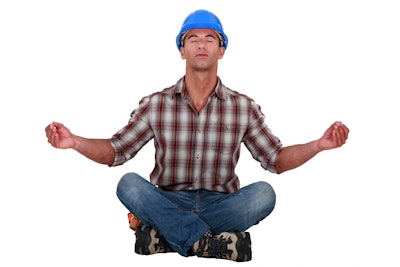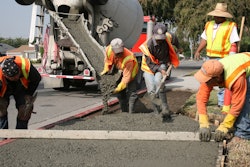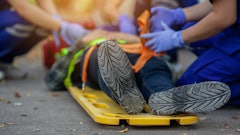
Editor's Note: The following article is brought to you by Carlos G. Aguirre, PhD, RDN, the senior editor at Daily CBD, an independent CBD reviews site. Dr. Aguirre completed his PhD in Pediatric Neurology at The University of Southern California.
Lower back pain is a very common problem among workers, affecting about 25.7 percent of the working population. However, of the different industries, industrial workers have one of the highest prevalence rates of low back pain.
According to a study, low back pain affects about 62 percent of industrial workers.
This high rate isn’t surprising though. The job requires industrial workers to do a lot of heavy lifting, bending, squatting and pushing, as well as pulling heavy loads. Repetitive motions like these, especially on a daily basis, stress the back and lead to low back pain.
Low back pain may be common among industrial workers and is easily treatable, but without proper management, it can become chronic. Not only can chronic low back pain affect a worker’s quality of life, but it can also affect his work — resulting in income loss.
If you’re suffering from occupational low back pain, know that you don’t have to live with it or have it affect your job. There are many ways you can prevent and control it.
Learn the proper lifting technique
Lifting heavy loads already strains your back and compresses the structures found in the spine. If done incorrectly you’re especially likely to develop low back pain. To avoid it at work, you have to learn how to properly lift heavy objects.
Below are the steps on how to lift heavy objects properly:
1. Widening the base of support
To start, you have to have a wide base of support. This means keeping your feet about shoulder-width apart, with one foot slightly in front of the other to improve your balance — standing close to the object.
2. Lifting the object
In picking up the object, squat down, bending your hips and knees and keeping your back straight. Make sure, too, that your shoulders are straight back and your chest is out.
Now, get a good grip on the object, keeping it close to your body. Gently straighten your knees and hips as you stand.
Don’t rotate your trunk as you’re lifting the object. This increases pressure on the back.
3. Turning while carrying the load
When navigating around with a heavy load, don’t twist your torso when changing directions. Instead, lead with your feet while keeping your back straight.
4. Setting the object down
Again, don’t bend your trunk when setting the object down. Instead, bend at the hips and knees and slowly place the object on the floor.
Learning the proper lifting technique can help prevent occupational low back pain. However, the company should also put in place several measures that reduce the risks such as mechanical hoists, which help reduce stress on the worker’s back.
 ©auremar – stock.adobe.com
©auremar – stock.adobe.com
Learn back exercises
Back exercises, while it strengthens the back, can also help you deal with low back pain. However, not all exercises are good for the back — some can lead to further aggravation and pain.
Here are some helpful exercising tips mentioned by Charline Favela, a practicing neurologist and Gold Bee co-founder, to strengthen the back and reduce your chances of injury:
1. Partial crunches
Lie on your back with your knees bent. Your feet should be firmly planted flat on the floor. You can either put your hands behind your head or have them crossed over your chest. Now, inhale deeply, tighten your abdominal muscles, and gently lift your upper body as you slowly exhale.
Do this at least 10 to 15 times each day.
2. Knee to chest
Using the same position, grab your left lower leg with both hands and pull it gently toward your chest. Hold the position for about 60 seconds and then gently release. Do the same for the right leg.
You may do this exercise three to five times per leg each day.
These exercises not only stretch and strengthen the back muscles but also open up the spine, relieving pressure and easing pain.
Use natural home remedies for low back pain
Natural home remedies can also help you deal with low back pain. These include:
1. Rest
Rest is important since it gives your painful back some time to heal, but limit your bed rest to only about two days.
Moving around and doing simple back exercises are still the best way to prevent back muscle stiffness and help reduce pain.
2. Cold compress
Place a cold compress on your back for about 20 minutes. Not only does this help with pain but it also reduces inflammation.
Cold compresses though are best given within the first 24 to 48 hours after the onset of low back pain.
3. Hot compress
For low back pain that has lasted more than 48 hours, you can apply a hot compress for 20 minutes. This eases pain, relaxes the back muscles and opens up the blood vessels. This is because an increased amount of blood flow flushes out the pain and inflammation-generating chemicals.
Seek complementary therapies for low back pain
Complementary therapies for low back pain also help ease pain and relax stiff muscles. These include:
1. Physical therapy
This makes use of modalities such as ultrasound, transcutaneous electrical stimulation, hot moist packs and exercises to relieve low back pain.
2. Acupuncture
Thin, sterilized needles are inserted into acupuncture pressure points to release blocked energy and bring balance back to the body.
3. Yoga
Similar to exercises, yoga teaches you how to relax your muscles and improve flexibility and strength.
4. Massage
Massage also helps reduce tension in the back muscles. It also promotes muscle relaxation and good blood flow.
Take over-the-counter medications for pain
If some of these techniques don't work to relieve your low back pain, you can always take an over-the-counter painkiller such as NSAIDs or nonsteroidal anti-inflammatory drugs. These reduce inflammation and control pain.
Take CBD oil
Over-the-counter pain medications may help reduce pain, but long-term use of NSAIDs produces negative side effects such as kidney and heart problems. It can also increase the risk of developing stomach ulcers.
If you want a safer alternative to OTC painkillers, you can try CBD oil. CBD is a cannabinoid extracted from marijuana and hemp. According to the World Health Organization, CBD is a safe and non-toxic compound. Compared to THC, this cannabinoid isn’t known to produce hallucinations or any psychoactive effects, making it a popular alternative therapy.
CBD helps with low back pain by stimulating the endocannabinoid system, one function of which is to regulate pain and inflammation. It also activates other biological systems responsible for pain control.
CBD comes in many forms such as soft gel capsules, oils, tinctures and topicals. Capsules are taken orally with food, while oils and tinctures are placed under the tongue. Topicals, on the other hand, are applied to the painful back area.
If you’re new to CBD, know that you can always start with a lower dose. For example, instead of taking one full dropper as recommended in the label, you can take half a dropper. If you didn’t feel any improvement in your low back pain after three days, then simply increase the dosage.
CBD is a sort of personalized therapy. You have to find a dosage that works perfectly for you.
Final thoughts – dealing with occupation low back pain
Industrial workers may have back-breaking jobs, but this doesn’t mean that you have to live with low back pain forever. Your back problem can be corrected through proper lifting techniques, exercises and home remedies. It can also be controlled and managed by OTC painkillers and CBD, which is a safer alternative to NSAIDs.
However, for lower back pain not relieved by any of these methods, we recommend seeing your primary care physician for proper diagnosis and treatment.



















